
Johannes Vermeer, van Delft Giclée Fine Art Prints 2 of 2
1632-1675
Dutch Baroque Painter
Johannes Vermeer, born in Delft in 1632, emerged from a household that deftly wove commerce with creativity. His father, a silk weaver of fine satin, also engaged in the trade of paintings, a practice that Vermeer would eventually inherit. This early immersion in both textiles and art laid a foundation for his nuanced sensitivity to surface, color, and light - qualities evident in his mature works. By 1641, the family was prosperous enough to acquire a sizable house known as the Mechelen, situated on Delft’s market square. From there, Vermeer’s father ran an inn and likely sold paintings, shaping the young artist’s understanding of the delicate interplay between commercial success and creative endeavor.
Vermeer formally joined the Saint Luke’s Guild in Delft on December 29, 1653, establishing his status as a master painter. Initially aiming to be a history painter, he produced several large-scale mythological and religious pieces. Before long, however, he shifted toward intimate genre scenes and carefully constructed interiors, suggesting an evolution in his aspirations or possibly the influence of new patrons. Although documentation regarding his training is nonexistent, Vermeer’s circle may have included luminaries such as Leonard Bramer and Carel Fabritius, both of whom were active in Delft and exhibited the painterly finesse that Vermeer would refine in his own compositions.
His conversion to Catholicism, around the time of his marriage in 1653 to Catharina Bolnes, further entwined his personal narrative with the city’s religious tapestry. Settling in the so-called Papenhoek, adjacent to Delft’s Jesuit church, Vermeer became ever more rooted in the civic and spiritual dimensions of his community. Despite his religious shift, no overtly devotional imagery dominates his mature work; instead, he explored the heightened stillness of everyday life, employing a sense of contemplative calm that distinguishes his paintings from those of his contemporaries.
Though Vermeer remained quietly revered in Delft, he never achieved extensive renown beyond his city’s borders during his lifetime. Contributing to this limited acclaim was the fact that many of his works likely resided in a single private collection. His art-dealing business faltered in the economic downturn of the early 1670s, leaving him in significant debt at the time of his death in 1675. Survived by his wife and eleven children, he left behind a body of work that numbers around thirty-five paintings. These canvases, rediscovered and appreciated more fully only in the late nineteenth century, speak to a singular artistic mind dedicated to observing, and ever so subtly dramatizing, the quotidian moments of Delft’s households.
Vermeer formally joined the Saint Luke’s Guild in Delft on December 29, 1653, establishing his status as a master painter. Initially aiming to be a history painter, he produced several large-scale mythological and religious pieces. Before long, however, he shifted toward intimate genre scenes and carefully constructed interiors, suggesting an evolution in his aspirations or possibly the influence of new patrons. Although documentation regarding his training is nonexistent, Vermeer’s circle may have included luminaries such as Leonard Bramer and Carel Fabritius, both of whom were active in Delft and exhibited the painterly finesse that Vermeer would refine in his own compositions.
His conversion to Catholicism, around the time of his marriage in 1653 to Catharina Bolnes, further entwined his personal narrative with the city’s religious tapestry. Settling in the so-called Papenhoek, adjacent to Delft’s Jesuit church, Vermeer became ever more rooted in the civic and spiritual dimensions of his community. Despite his religious shift, no overtly devotional imagery dominates his mature work; instead, he explored the heightened stillness of everyday life, employing a sense of contemplative calm that distinguishes his paintings from those of his contemporaries.
Though Vermeer remained quietly revered in Delft, he never achieved extensive renown beyond his city’s borders during his lifetime. Contributing to this limited acclaim was the fact that many of his works likely resided in a single private collection. His art-dealing business faltered in the economic downturn of the early 1670s, leaving him in significant debt at the time of his death in 1675. Survived by his wife and eleven children, he left behind a body of work that numbers around thirty-five paintings. These canvases, rediscovered and appreciated more fully only in the late nineteenth century, speak to a singular artistic mind dedicated to observing, and ever so subtly dramatizing, the quotidian moments of Delft’s households.
38 Vermeer Artworks
Page 2 of 2
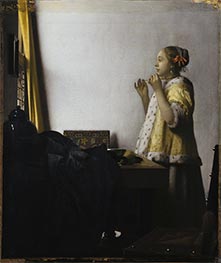
Giclée Canvas Print
$69.56
$69.56
SKU: 1090-VVD
Johannes Vermeer, van Delft
Original Size:56.1 x 47.4 cm
Gemaldegalerie, Berlin, Germany
Johannes Vermeer, van Delft
Original Size:56.1 x 47.4 cm
Gemaldegalerie, Berlin, Germany
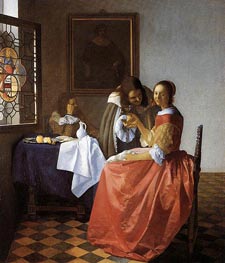
Giclée Canvas Print
$71.06
$71.06
SKU: 1094-VVD
Johannes Vermeer, van Delft
Original Size:78 x 67 cm
Herzog Anton Ulrich-Museum, Braunschweig, Germany
Johannes Vermeer, van Delft
Original Size:78 x 67 cm
Herzog Anton Ulrich-Museum, Braunschweig, Germany
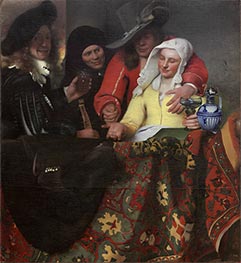
Giclée Canvas Print
$75.72
$75.72
SKU: 1097-VVD
Johannes Vermeer, van Delft
Original Size:143 x 130 cm
Gemaldegalerie Alte Meister, Dresden, Germany
Johannes Vermeer, van Delft
Original Size:143 x 130 cm
Gemaldegalerie Alte Meister, Dresden, Germany
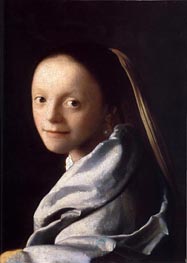
Giclée Canvas Print
$54.63
$54.63
SKU: 1078-VVD
Johannes Vermeer, van Delft
Original Size:44.5 x 40 cm
Metropolitan Museum of Art, New York, USA
Johannes Vermeer, van Delft
Original Size:44.5 x 40 cm
Metropolitan Museum of Art, New York, USA
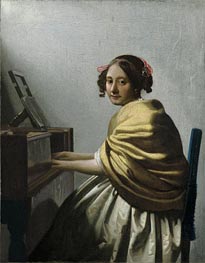
Giclée Canvas Print
$54.63
$54.63
SKU: 3819-VVD
Johannes Vermeer, van Delft
Original Size:25.3 x 19.9 cm
Private Collection
Johannes Vermeer, van Delft
Original Size:25.3 x 19.9 cm
Private Collection
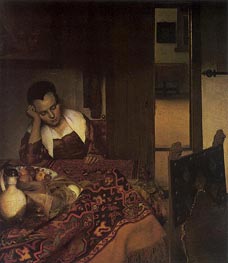
Giclée Canvas Print
$62.12
$62.12
SKU: 1098-VVD
Johannes Vermeer, van Delft
Original Size:87.6 x 76.5 cm
Metropolitan Museum of Art, New York, USA
Johannes Vermeer, van Delft
Original Size:87.6 x 76.5 cm
Metropolitan Museum of Art, New York, USA

Giclée Canvas Print
$64.14
$64.14
SKU: 1081-VVD
Johannes Vermeer, van Delft
Original Size:51.5 x 45.5 cm
National Gallery, London, UK
Johannes Vermeer, van Delft
Original Size:51.5 x 45.5 cm
National Gallery, London, UK
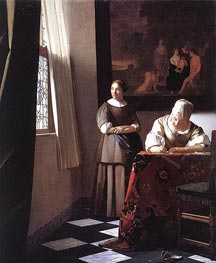
Giclée Canvas Print
$83.65
$83.65
SKU: 1084-VVD
Johannes Vermeer, van Delft
Original Size:71.1 x 58.4 cm
National Gallery, Dublin, Ireland
Johannes Vermeer, van Delft
Original Size:71.1 x 58.4 cm
National Gallery, Dublin, Ireland
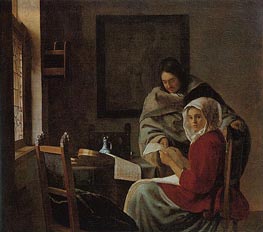
Giclée Canvas Print
$54.63
$54.63
SKU: 1092-VVD
Johannes Vermeer, van Delft
Original Size:39.3 x 44.4 cm
Frick Collection, New York, USA
Johannes Vermeer, van Delft
Original Size:39.3 x 44.4 cm
Frick Collection, New York, USA

Giclée Canvas Print
$54.63
$54.63
SKU: 1087-VVD
Johannes Vermeer, van Delft
Original Size:20 x 17.8 cm
National Gallery of Art, Washington, USA
Johannes Vermeer, van Delft
Original Size:20 x 17.8 cm
National Gallery of Art, Washington, USA

Giclée Canvas Print
$63.58
$63.58
SKU: 1093-VVD
Johannes Vermeer, van Delft
Original Size:50.5 x 46 cm
Frick Collection, New York, USA
Johannes Vermeer, van Delft
Original Size:50.5 x 46 cm
Frick Collection, New York, USA

Giclée Canvas Print
$71.82
$71.82
SKU: 1095-VVD
Johannes Vermeer, van Delft
Original Size:67.7 x 79.6 cm
Gemaldegalerie, Berlin, Germany
Johannes Vermeer, van Delft
Original Size:67.7 x 79.6 cm
Gemaldegalerie, Berlin, Germany

Giclée Canvas Print
$54.63
$54.63
SKU: 1069-VVD
Johannes Vermeer, van Delft
Original Size:44 x 38.5 cm
Rijksmuseum, Amsterdam, Netherlands
Johannes Vermeer, van Delft
Original Size:44 x 38.5 cm
Rijksmuseum, Amsterdam, Netherlands
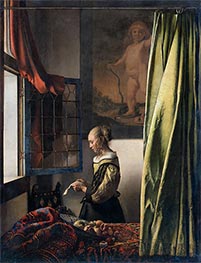
Giclée Canvas Print
$63.23
$63.23
SKU: 18851-VVD
Johannes Vermeer, van Delft
Original Size:83 x 64.5 cm
Gemaldegalerie Alte Meister, Dresden, Germany
Johannes Vermeer, van Delft
Original Size:83 x 64.5 cm
Gemaldegalerie Alte Meister, Dresden, Germany